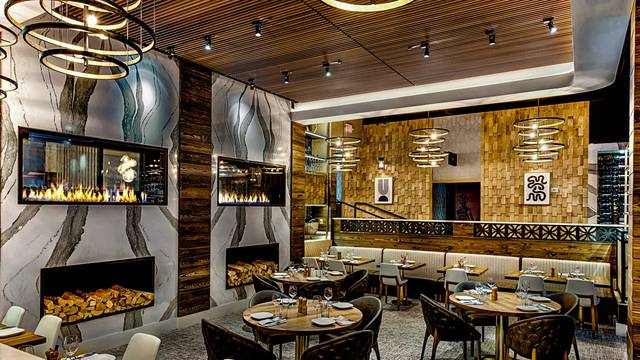Savor Authentic Asian Cuisine With a Pan-Asian Twist for a Culinary Adventure
Embarking on a culinary trip via authentic Oriental cuisine, improved with a Pan-Asian twist, uses an one-of-a-kind possibility to check out the abundant tapestry of tastes that specify the region's varied cooking traditions. This experience welcomes you to relish the charming balance of tastes-- wonderful, salty, spicy, and sour-- balanced by aromatic herbs and flavors. Think of the cutting-edge blend of Thai curry and ramen or the unanticipated joy of sushi burritos. As you ponder these attracting meals, take into consideration the social stories and historic influences that shape them, each bite using a story waiting to be found.

Exploring Pan-Asian Tastes
In the world of worldwide gastronomy, Pan-Asian food attracts attention for its amazing variety and the harmonious interplay of tastes from numerous Oriental cultures. This culinary approach celebrates the unique components and rich practices located across the continent, developing a tapestry of tastes that is both gratifying and intriguing. Secret to Pan-Asian cuisine is its ability to stabilize contrasting flavors-- sweet, salty, spicy, and sour-- while highlighting the freshness and high quality of each ingredient.
From the umami-rich soy sauce of Japan to the fiery chili peppers of Thailand, Pan-Asian cuisine provides an extensive combination of flavors. These aspects are commonly combined in innovative methods, enhancing dishes with layers of complexity. For example, the usage of aromatic natural herbs such as lemongrass and cilantro, usual in Vietnamese and Thai food, includes a rejuvenating illumination to recipes, while the consolidation of coconut milk supplies a velvety, rich texture.
The focus on fresh fruit and vegetables and aromatic spices guarantees that each meal is not just a banquet for the taste however also for the senses. Pan-Asian cuisine welcomes restaurants to embark on a cooking journey, discovering the substantial and varied landscapes of Eastern gastronomy with every bite.
Combination Recipes to Attempt
While Pan-Asian cuisine is celebrated for its conventional tastes, the modern-day culinary landscape is significantly welcoming combination dishes that mix these timeless aspects with influences from other regions. This innovative technique not only honors the abundant heritage of Eastern cookeries however likewise introduces unique taste experiences that interest contemporary palates.
A prime instance of such a combination dish is the Korean-Mexican taco, where seasoned bulgogi beef is wrapped in a cozy tortilla, topped with kimchi and a hot gochujang-infused salsa. This combination weds the bold, full-flavored flavors of Korea with the vibrant, fresh aspects of Mexican cuisine. Likewise, sushi burritos have gotten popularity, integrating the delicate creativity of Japanese sushi with the hearty, hand-held convenience of a burrito, often featuring blend ingredients like tempura shrimp and avocado with a drizzle of wasabi mayo.
An additional noteworthy meal is Thai curry ramen, which instills the luscious, aromatic seasonings of Thai curry into the calming broth of traditional Japanese ramen, developing a harmonious blend that tantalizes the senses. These blend dishes prolong past mere novelty; they stand for a culinary dialogue in between societies, encouraging exploration and technology in the world of Pan-Asian food.
Essential Active Ingredients and Spices
To absolutely appreciate Pan-Asian cuisine, one must comprehend the necessary components and flavors that develop its structure. This varied cooking style draws from a rich tapestry of Oriental traditions, utilizing a harmonious blend of textures and flavors. Key components consist of soy sauce, fish sauce, and oyster sauce, which pass on a full-flavored umami deepness necessary to Oriental recipes. Corresponding to these are rice vinegar and mirin, offering a fragile level of acidity and sweet taste.
Aromatic components are pivotal, with ginger, garlic, and lemongrass being ubiquitous across numerous Pan-Asian dishes. These ingredients offer a fragrant base that boosts the intricacy of tastes. Flavors such as celebrity anise, cardamom, and cinnamon present warmth and character, echoing impacts from regions like China and India.

Food Preparation Strategies and Tips
Grasping the art of Pan-Asian cuisine needs knowledge with its distinctive cooking techniques, each adding to the vibrant tapestry of flavors this first watch near me cooking custom is celebrated for. Central to these techniques is the stir-fry, a quick food preparation technique that maintains the nutritional stability and dazzling shades of ingredients. Making use of a wok, the stir-fry method enables for also heat distribution, essential for achieving the characteristic appearance and taste equilibrium of Pan-Asian recipes.
Another basic method is steaming, particularly prevalent in Chinese cuisine. This gentle method preserves the natural flavors and nutrients of components, making it ideal for seafood and vegetables. Dumplings, a beloved staple, frequently take advantage of steaming, leading to soft, succulent structures.
Barbecuing, also indispensable, passes on smoky depths to recipes such as Oriental bulgogi or Japanese yakitori (pan asian restaurant Islamabad). This technique often entails seasoning components, enabling flavors to pass through deeply prior to cooking over an open flame or warmer
Last but not least, grasping the art of balancing tastes-- pleasant, sour, salted, bitter, and umami-- is important. Appropriately layering these elements can boost a recipe from normal to amazing, providing a facility and pleasing cooking experience that personifies the essence of Pan-Asian food.
Eating Experiences Worldwide
Around the world, Pan-Asian food uses an unmatched dining experience, celebrated for its abundant tapestry of flavors and vivid presentations. This culinary sensation has gone beyond cultural limits, capturing the hearts and tastes of food lovers worldwide. In cosmopolitan cities like New York, London, and Sydney, Pan-Asian dining establishments offer as melting pots where culinary practices from Thailand, Japan, China, and beyond merge, giving diners with an eclectic mix of dishes that highlight the region's variety.
The international appeal of Pan-Asian cuisine depends on its capacity to provide both authenticity and technology. Cooks masterfully marry standard ingredients such as lemongrass, soy sauce, and miso with contemporary techniques, leading to recipes that are both refreshingly new and familiar. This fusion enables restaurants to start a cooking trip that respects heritage while embracing modernity.
Furthermore, dining experiences are raised with attentively designed environments that reflect the ethos of Pan-Asian appearances. From minimalist Japanese-inspired interiors to vibrant Thai-themed spaces, each dining establishment supplies a distinct ambiance that complements the culinary offerings. Therefore, patrons are not merely consuming a dish but partaking in a cultural experience, look these up making Pan-Asian eating a genuinely worldwide phenomenon.
Final Thought
The exploration of Pan-Asian cuisine offers an extensive understanding of the detailed interaction of flavors and culinary practices throughout Asia. By welcoming combination recipes such as Thai curry ramen and sushi burritos, the culinary journey not just highlights the versatility of typical active ingredients however likewise showcases innovative modern-day methods. This gastronomic experience, enriched by essential seasonings and cooking methods, gives an one-of-a-kind opportunity to appreciate the multiculturalism and cooking artistry that define Pan-Asian cuisine on an international scale.
Embarking on a cooking journey via genuine Asian food, enhanced with a Pan-Asian twist, offers an one-of-a-kind chance to explore the abundant tapestry of tastes that specify the area's diverse cooking customs.In the world of international gastronomy, Pan-Asian cuisine stands out for its remarkable variety and the unified interplay of tastes from various Eastern cultures. Secret to Pan-Asian food is its capability to stabilize contrasting tastes-- sweet, salty, spicy, and sour-- while highlighting the quality and high quality of each active ingredient.

 Lark Voorhies Then & Now!
Lark Voorhies Then & Now! Gia Lopez Then & Now!
Gia Lopez Then & Now! Sam Woods Then & Now!
Sam Woods Then & Now! Danielle Fishel Then & Now!
Danielle Fishel Then & Now! Suri Cruise Then & Now!
Suri Cruise Then & Now!